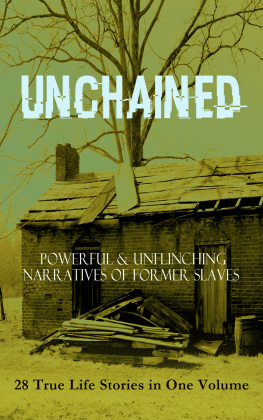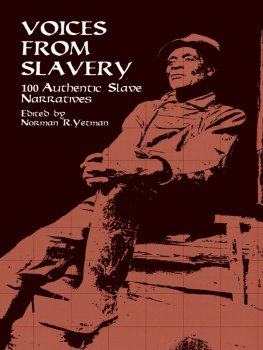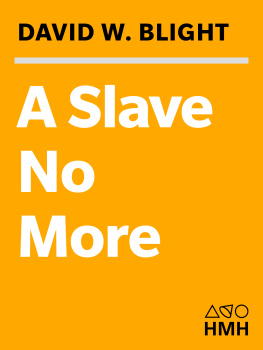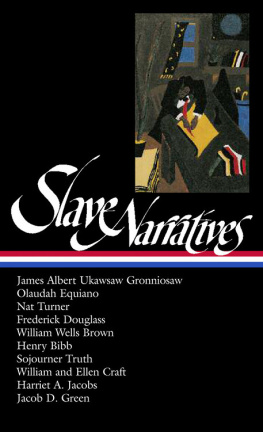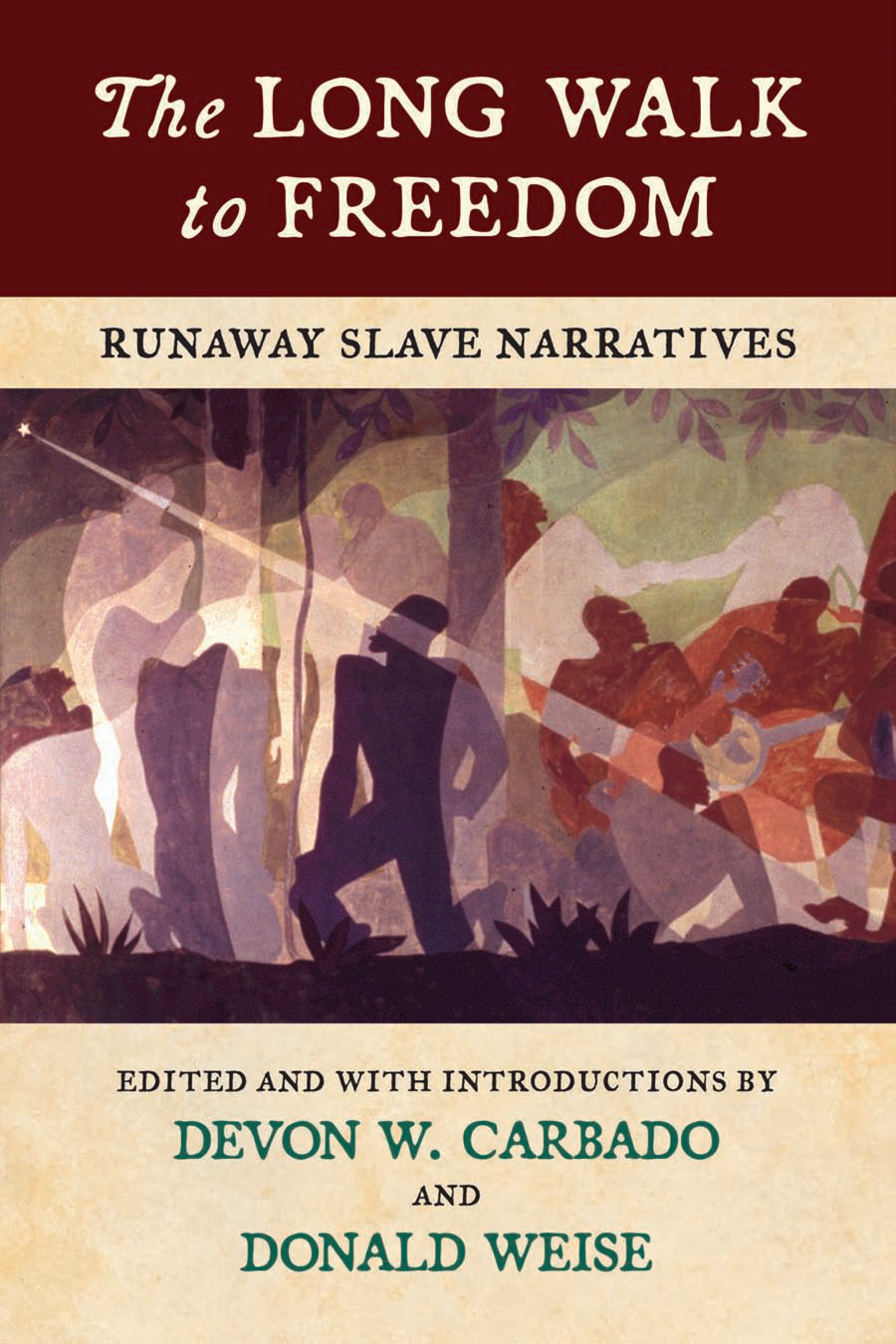THE LONG WALK TO FREEDOM

Runaway Slave Narratives

Edited and with Introductions by
DEVON W. CARBADO AND DONALD WEISE
Beacon Press
BOSTON
For George F. Carbado
D. C.
For David Hilliard
D. W.
CONTENTS

INTRODUCTION
I Will Run Away
God, deliver me! Let me be free! Is there any God? Why am I a slave? I will run away. I will not stand it. Get caught, or get clear, Ill try it. I had as well die with ague as the fever. I have only one life to lose. I had as well be killed running as die standing.
FREDERICK DOUGLASS, NARRATIVE OF THE LIFE OF FREDERICK DOUGLASS
A decade ago, John Hope Franklin and Loren Schweninger published Runaway Slaves: Rebels on the Plantation. The book was part of a much broader literature that challenged the idea that slaves were generally pliant and resigned to their roles as human chattel. While W. E. B. Du Bois, in Black Reconstruction in America, had argued vociferously against the idea of slaves as docile and pliant, Franklin and Schweningers book, among other works, helped to solidify the idea. Far from passively acquiescing to what was euphemistically referred to as the Souths peculiar institution, slaves rebelled against their masters and ran away whenever they could. That they risked life and limb to do so was itself an indication of the brutality of slavery.
Runaway Slaves was successfulboth in commercial terms and with respect to the critical acclaim the book received. But despite its success, since then only a few texts focusing solely on runaway slaves have been published. To be sure, dozens of books of slave narratives are already on the market; the autobiographies of Frederick Douglass and Sojourner Truth, for example, can be found readily. Indeed, slave narratives remain one of the most enduring genres of African American literature.
The Long Walk to Freedom contains the first-ever collection of fugitive slave narratives, presented as a unique genre, not simply as slave narratives more generally. The twelve narratives collectively span approximately seventy-six years. Excerpts from the best-known book-length narrativesincluding those by Douglass, Nat Turner, Harriet Jacobs, William and Ellen Craftstand alongside narratives that havent been published in more than a hundred years.
Although most slave narratives were written or recorded after Abolition, the most widely readeven todayare antebellum fugitive accounts. Unlike the narratives of ex-slaves who had purchased their freedom prior to the Civil War or were emancipated afterward, fugitives stories offer dramatic exploits that overcome staid polemics. Here, one finds patrols of slave catchers and their hounds in relentless pursuit of runaways, wild animals on the attack, intrigue on the Underground Railroad, slaves dangerously masquerading as freed peoplesometimes disguised as the opposite sexin order to pass. The runaway narrative of William Craft, for example, describes how he and his wife, neither of whom was literate, employed public transportation to make their way from Georgia to Pennsylvania. To do so, Ellen Craft disguised herself as a white man traveling with her slave companion.
One finds in these narratives romantic elements as wellslaves running hundreds, if not thousands, of miles to be reunited at all costs with a loved onethat help establish emotional connections between the author and reader, much as if one were reading a novel.
But these are not works of fiction.For example, Isaac D. Williamss story conveys the strong, rebellious, and persistent spirit that many slaves possessed in order to run away. In his flight north, Williams was initially pursued by bloodhounds, which he was able to kill. But he was eventually caught and shot, his body riddled with bullets. Nevertheless, Williams survived, managed to escape jail, and fled north again, continuing to defy the dangers of nature and the numerous police and slave owners he encountered along the way.
Slaves ran away for various reasons, among them brutal treatment; confrontations with an owner or overseer; the opportunity to escape; the fear of being sold or transferred, particularly away from ones family; and the fundamental desire to be free. Moses Ropers narrative documents the severe floggings he received from several different slave owners, five hundred lashes at the worst. His repeated attempts to escape, at the risk of again being flogged, no doubt were spurred by these acts of violence, which over time quite literally broke slaves down. My natural elasticity was crushed, wrote Frederick Douglass in his narrative on the impact of being repeatedly beaten. [M]y intellect languished, the disposition to read departed... the dark night of slavery closed in upon me; and behold a man transformed into a brute!
According to most historians, the dark night of slavery traces back to the first African people brought to British America in August 1619 and sold to English colonizers in Jamestown, Virginia. Some of the relatively small number of Africans in the colonies during this period likely worked as indentured servants side-by-side with white indentured servants who had fled the economic hardships of Europe. Others worked as slaves. As slaves did, white indentured servants often ran away and were punished harshly upon return. Thus, it was not uncommon to see advertisements in local newspapers for both black and white fugitives. For example, the September 26, 1751, edition of the Pennsylvania Journal sought the return of an Irish Servant But because whiteness carried with it the presumption of freedom and blackness the presumption of slavery, indentured whites had an easier time escaping their servitude than did blacks.
In 1775, on the eve of the Revolutionary War, slavery in the thirteen Colonies was more than 150 years old and had become part of the legal and racial caste system. But the revolutionary fervor of the time made the institution of slavery more vulnerable than it had ever been. The ideals of the colonistsfreedom from English oppression, and self-determinationwere at least somewhat, if not thoroughly, inconsistent with the idea of slavery.
Other factors also helped to delegitimize the institution. One was economic: the tobacco market had crashed, and the wheat crops that replaced tobacco did not require the same kind of labor-intensive work, reducing the demand for slave workers. Compounding matters was a general recession, which found many slave owners unable to feed and support their unpaid labor force.
Religion also generated abolitionist ideas. The Great Awakeninga movement that reinvigorated Christianity by encouraging an emotional engagement with religion, a sense of personal spiritual commitment, and feelings of guilt for ones moral transgressionsparticularly motivated Baptists and Methodists to save the souls of black folks.
Moreover, Lord Dunmore, the dethroned governor of Virginia, to cite one example, issued a proclamation of freedom to all slaves who would fight for the king. This invitation also undermined slavery, and many slaves ran away in search of that promised freedom.
Finally, the Revolutionary War itself weakened the institution of slavery by creating runaway opportunities through general upheaval (for example, slave masters fled war-torn territories along with their slaves) and because the significant number of white men who left their plantations to join the Patriot Army created an absence that the slaves could and did exploit. More than twenty thousand slaves, many runaways, ended up under the authority of the British military during this time.


